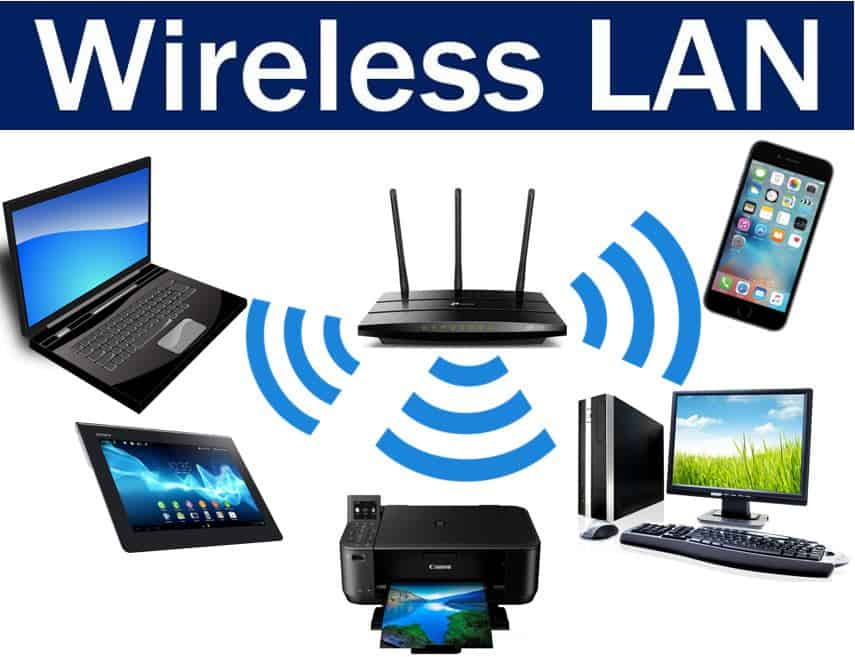Wireless LAN (WLAN) – definition and meaning
Wireless LAN, also called WLAN or Wireless Local Area Network, is an information technology (IT) term that refers to a local area network that does not need wires (cables) to connect different devices such as smartphones, tablets, laptops, desktops, servers, clients, printers, etc. Instead of cables, communication is achieved through radio waves and IEEE 802.11. LAN stands for local area network.
The speed at which data is transferred – the data transfer rate – with wireless LAN is reduced by obstacles such as walls, as well as EMI (electromagnetic interference) from other electronic and electrical devices.
Most wireless LAN systems have a range of approximately 130 feet. Technologies such as spread spectrum can extend the range considerably – up to at least 800 feet, and overcome most of the EMI problems.
“A wireless local area network (WLAN) is a wireless distribution method for two or more devices that use high-frequency radio waves and often include an access point to the Internet.”
“A WLAN allows users to move around the coverage area, often a home or small office, while maintaining a network connection. A WLAN is sometimes call a local area wireless network (LAWN).”
 While a Wireless LAN refers to any LAN (local are network) that a mobile user can connect through a radio (wireless) connection, Wi-FI is a term for certain kinds of WLANs that use specifications in the 802.11 wireless protocol family.
While a Wireless LAN refers to any LAN (local are network) that a mobile user can connect through a radio (wireless) connection, Wi-FI is a term for certain kinds of WLANs that use specifications in the 802.11 wireless protocol family.
Pros and cons of wireless LAN systems
Advantages:
- Users can access the network from wherever they want within the system’s range. They are not limited by the length of a cable.
- Many places outside the home or the workplace have WLANs. This means that users can go online while commuting on a train, at airports, cafes, buses (in many countries), etc.
- Most smartphones today that have access to the Internet anywhere can be converted into hotspots – your laptop, for example, can go online wirelessly via your smartphone.
- Setting up a wireless LAN is done with a wireless access point or wireless router. These devices can handle several connections simultaneously. Wired networks, which require cables, can be difficult for some types of places.
Disadvantages:
- Wireless LAN systems use radio waves to facilitate communication. The data being transferred needs to be encrypted.
- The signals are noisy compared to those sent through cables. In order to correct errors, more bandwidth is required.
- There are a number of reliability problems, especially those related to interference from other electronic and electric devices.
- Wireless LAN systems are considerably slower than wired ones. For most users, however, this does not usually matter.
Wireless LAN – short history
The first wireless LAN became operational in 1971. It was set up by Norman Abramson, a University of Hawaii professor who used low-cost ham-like radios. His system, called ALOHAnet, consisted of seven computers deployed over four islands to communicate with a central computer without using phone lines.
Initially, wireless LAN hardware was extremely expensive, so the system was only used as an alternative to cabled LAN where cabling was either impossible or difficult.
During the initial years, industry-specific solutions and proprietary protocols were used. By the end of the last century, these were replaced by standards, mainly the various versions of IEEE. 802.11 (in devices using the Wi-FI brand name).
The European Telecommunications Standards Institute (ETSI) had a system called HiperLAN/1, which was approved in 1996. HiperLAN/2 became operational in the year 2000.
Neither of the two European standards achieved the commercial success of 802.11. However, much of the work done on HiperLAN/2 still exists in the physical specification (PHY) for IEEE 802.11a, which is almost identical to the PHY of HiperLAN/2.
802.11n was added to 802.11 in 2009. It operates both the 5 GHz and 2.4 GHz bands at a maximum data transfer rate of 600 Mbit/s. Most modern routers can utilize both wireless bands – they are known as dualband routers – so that data communications can avoid the crowded 2.4 GHz band, which is also shared with microwave ovens and Bluetooth devices.
The 5 GHz band is also broader than the 2.4 GH band, and it has more channels, which means more devices can share the space.
In 1997, a HomeRF group formed to promote technology for use in the home. However, at the end of 2002 it disbanded.

